by Charles River Interactive | November 20, 2019 | SEO, SEO Blogs, SEO Industry Trends
If you’ve spent any of your company’s time or marketing budget on SEO, you’ve likely heard about backlinks. Backlinks help determine how your website ranks in Google’s search results and for what keyword your website is ranked. While the concept of getting other webpages to link to your site is relatively simple, understanding how they interact with your site and with Google’s algorithm is far from straightforward.
Why are backlinks important?
To determine what and where your website ranks in Google’s
search results, they use a variety of factors, including backlinks. While you
can have the slickest, fastest, and easiest-to-use website in the world, if
there are no backlinks to it, Google may not rank it as well as it deserves
because no other website has given it a “vote” by linking to it!. So, if you’re trying to rank your
organization’s website, it would make sense to reach out to people to build the
backlinks, or alternately hire an SEO firm to build those backlinks. While both
can be good, indiscriminately building links either through your own efforts or
by hiring a third party can backfire, leaving you wondering “How can I get rid
of these spammy backlinks”?
How Bad are your Backlinks?
So, while you can build a multitude of really bad backlinks
really quickly and damage your traffic almost as fast, there are ways to fix
the problem. Namely Google’s disavow tool, which can help your recovery from
spammy backlinks. Google doesn’t encourage its use, and there’s a very
important reason why: Nowadays, not all bad backlinks cause ranking penalties. This
is because of Google’s Penguin updates, which separated the ideas of a spammy
website and a low-quality website. Spammy websites differ from
websites that Google ranks poorly because they actively attempt to scam a
user or manipulate a search engine. A low-quality website is just that –
low quality. Things like misspelling, bad grammar, bad user experience or a
poorly structured site doesn’t necessarily mean spammy, it just means that
search engines will rank other pages about the same subject higher; and links
from the low-quality domains will not receive nearly as much (or in many cases,
any) weight in Google’s ranking algorithm. Because of this, disavowing links is not
nearly as effective as it was prior to the Penguin update.
As a result, it’s harder to shape your website’s backlink
profile to what you need it to be – if
you’ve got a website with thousands of backlinks, and half are from low-quality
domains, that’s still a bunch of pages that you’d need to review in some way to
determine which to cut and which to keep, rather than only going by
industry-standard metrics like Moz’s Domain Authority to determine the
backlink’s value.
So, armed with this information,
how do you find the bad backlinks and disavow them? It’s actually relatively simple: you filter
backlinks with features in common that look spammy; this includes aspects of
the domain like:
Low domain-level scores on SEO
Tools
Lots of SEO tools give their own
rating to domains based on things like ranking, domain age, content length,
content quality, backlink quality, etc. Regardless if you’re using Ahrefs,
Brightedge, SEMRush, or another tool, find the lowest-rated pages and filter
out everything else. That’ll give you your initial pool of low quality and
spammy backlinks.
Spammy Top Level Domains
Top-level domains (TLDs) appear at the end of a domain name, for example the top-level domain for https://charlesriverinteractive.com is “.com”. More obscure top-level domains (like “.biz”, “.pizza”, “.info”) are cheaper to buy than more common ones like “.com”, “.org”, or “.net”. Because of this, spammers love less-common top-level domains, and they buy them in bulk. Some are almost entirely used by spammers – according to The Spamhaus Project , 94% of websites using the TLD “.gdn” are spam. Look for groups of domains with TLDs that are obscure and rate highly for webspam – these URLS are good candidates for disavowal.
Spammy Domain Names
While it’s not necessary that a
domain’s name match the content on the site, it’s easy to tell if a website has
a spammy domain name. Look for terms related to “adult” searches, (adult
videos, gambling, etc.) and other “spammy” search terms, like asbestos and
payday loans.
Beyond these types of terms, look
for “copycat” websites – they’ll have a
URL similar to a well-known, authoritative website, but with a different
top-level domain (think “washingtonpost.pizza” or “forbes.gdn”). These are most
definitely spam – it’s common for organizations to buy lookalike domains so
that they don’t get used by someone else, but they’ll usually never host
anything on those domains, or at most redirect to their real website. If
they’re backlinking to you, they’re most likely not legitimate, and you can be
confident in disavowing them.
Domains on the Same IP
The internet has greatly expanded
in the last 20 or so years, and while IP addresses were usually assigned to one
domain, it’s not uncommon to find multiple legitimate domains on the same IP.
However, any domains that meet one or more of the last three criteria and share
IP addresses are absolutely, no-doubt-about-it spam.
Generating a Disavow List
So now that we know the signs of a spammy domain, how do you get the list? The most straightforward way is also the most laborious – generate the list by filtering for these spammy domain indicators in Excel. However, it takes hours to do right and it might be worth engaging the services of a reputable marketing firm to speed up the process and ensure an accurate and effective domain-based link disavow list. If this is the case, don’t hesitate to contact Charles River Interactive! We’ve got the experience and technology to find spammy backlinks and create the strategies that elevate your business’ web presence and drive the traffic you need for business growth.
by Charles River Interactive | May 14, 2018 | Industry Trends, Local SEO, Organic Search, SEO, Uncategorized
“Alexa, order floor mats for my Honda Pilot.”
“OK Google, find me a place for tacos right now.”
“Hey Siri, when is World Immunization Week?”
Voice search is more and more a part of our everyday lives. As the technology becomes more commonplace, and as developers expand the number and types of actions you can complete using just your voice, the opportunities for businesses grow and change on a seemingly daily basis.
We’ve written about optimizing for voice search before; here is what we have learned since in preparing our clients for a mobile, screen-less future in search.
Who Uses Voice Search?
- 30% of web browsing sessions will be screen-less by 2020, according to Gartner
- Voice search usage skews heavily toward Millennials—more than 1 out of 3 Millennials do or plan to use a voice-search aided virtual assistant, as compared to just 1 out of every 10 members of the Baby Boomer generation, according to eMarketer
- Millennials are more likely to use voice search in part because they are the largest group of owners of a smart home device, according to Walker Sands
- Younger demographics are more likely to use voice search on a mobile device, according to Global Web Index—25% of users ages 16-24 reported having used a voice search tool on their mobile device in the last month
Why Voice Search?
It is possible to predict why a user might choose to search via voice based on readily available information such as device and location.
Mobile Voice Search is Local SEO
Voice searches originating on a mobile device tend to be location-dependent—that is, users typically search for strings such as, “[service] near me”, or “nearby [product]”.
The optimal strategy for capturing traffic from these voice searches has not changed much since its debut. We know that Google voice search, for instance, relies on structured data of the sort that drives the appearance of featured snippets but which explicitly includes location and other relevant information, such as hours. A thorough local SEO strategy should be sufficient to ensure that your site is positioned to capture such traffic. If you’re not sure if your business or website is already capitalizing on local SEO opportunities, reach out to us!
Smart-home Voice Search is an Ecommerce Opportunity
According to data published via Statista, the general retail ecommerce sector in the US economy is estimated to have totaled over $409 billion in sales in 2017, and is forecast to surpass $638 billion by 2022. Voicebot.ai, meanwhile, pegs the US retail ecommerce voice search market currently as a $1.8 billion segment—a figure expected to rise to $40 billion within the next five years.
Voice search may comprise only a small portion of the retail ecommerce sector at the moment—0.44%, according to the above estimates—but that segment is growing faster than the overall ecommerce sector. Based on the above figures, by 2022, voice search will be component in 6.27% of all ecommerce transactions. The pie is growing, and this slice is growing even faster!
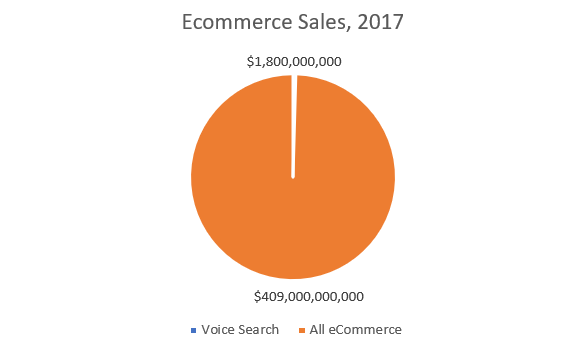
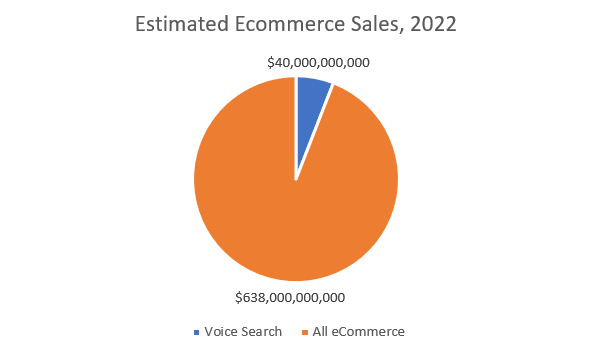
The retail ecommerce pie is growing, and the voice search slice is growing even faster!
The largest share of voice search ecommerce transactions are initiated via a smart-home device. According to GeoMarketing, 82% of Amazon Echo/Dot owners subscribe to Amazon Prime. That fact facilitates roughly two-thirds of purchases, all of which can be categorized as staples—groceries, entertainment, electronics, and clothing.
This represents both an opportunity and an obstacle. Customers are comfortable purchasing staples sight unseen. “Alexa, order Bounty paper towels” is a lot different from “Alexa, order floor mats for my new car.” Shoppers want to discover new products visually; voice search—absent broader integration into a smart home—may not be the right method for that, or one that we would expect users to adopt.
If we are to prepare for a future where shoppers expect to discover and shop for new or novel products via voice search, we likely do not need to significantly alter our strategies. A recent Search Engine Land article laid out what might be over and above what we consider SEO best practices—a list that starts and ends, for most ecommerce retailers, with the suggestion to optimize content for conversational keywords.
Ecommerce and Long-tail Keywords
Conversational keywords can be understood as phrases and complete sentences. Consider the example above—“OK Google, order floor mats for my Honda Pilot.” We would expect a search engine to parse this as “floor mats” + “Honda Pilot”, with search intent clearly aligned around purchasing as opposed to information or research. We would expect a traditional search engine results page to be populated with product pages; we also would expect to see a Google Shopping grid on the right-hand rail. And, what do you know:

An example of a Google SERP for a long-tail, purchase-motivated search query
Our clients’ sites have gained qualified, purchase-ready traffic with holistic content strategies. By aligning the informational blog posts or evergreen articles with custom product descriptions, we have been able both to improve the average position for target keywords and to increase the total number of keywords for which the page ranks (and, over time, ranks well).


A holistic SEO content strategy maximizes content production beyond the initial article
Many sites assume that blog posts and evergreen articles are the extent of their content production. We have found that nothing could be farther from the truth—in fact, the initial blog post really is the point of origin. Like a radio signal, it spreads across your site via the pages to which it links, and in turn the pages to which they link.
By selecting, for instance, to link to a product with several related products displayed beneath, rather than linking to a dead-end product page, we accomplish a primary eCommerce SEO goal, linking to multiple product pages within three clicks of the homepage.
By writing expanded descriptions on those product pages, we are able to more fully educate search engines as to what products we sell, who might be interested in them, and for what they might be used. In a nutshell, this is semantic SEO.
This type of content is fantastic if you are adhering to Google’s stated mandate—that you design your site to satisfy the user’s intent. Through the lens of voice-search optimization, however, there has to be another side to the coin.
Structured Data
The virtual assistants powering voice search—Alexa, Siri, The Google Assistant; pick your poison—are designed to interpret natural speech. It is possible that, over time, they will be able to crawl, read, and understand normal content with the same level of comprehension as a typical internet user. In the interim, however, we can look at what we know about where virtual assistants find the information they repeat back in response to a voice search.
A recent Backlinko study considered 10,000 Google Home search results. The study includes plenty of valuable insight; here are our 3 key takeaways:
- 41% of voice search answers came from a featured snippet
- The average answer came from a page with a word count well over 2,000
- Very few results had the exact query in their title tag
Each of the above supports the advice we have given our clients on this topic. Featured snippets are important, and there are steps you can take to encourage Google to display information from your site in the knowledge panel, but Google themselves have shown a clear preference for high domain authority sites in this regard, in particular. The best you can do is prepare and develop your site in such a way that it is possible for Google to build a snippet, should they decide doing so is the best way to address a user’s query.
Of course, a featured snippet is not the only use for structured data on your site. And here, we see some of the greatest potential for growth across the voice search ecommerce landscape. Amazon, Apple, and Google all may want to develop their virtual assistants to the point where they easily can parse relevant text out of long-form content—but, in the interim, and if the goal is to answer a user’s ecommerce-related voice search, we can expect them to use the most accurate information available that their respective spiders can readily digest. And that, for now and the foreseeable future, is structured data.
Articles can be associated with the Question schema. There is a product schema, and there is no shortage of additional structured data types, objects, and properties that can be built out for most pages—images, alternative names, prices, dimensions, many of which also have particular machine-readable formats that improve search engines’ understanding of your site.
Optimizing for voice search is little different from optimizing for organic search. One key to success is understanding how voice search engines consume and synthesize information—and how you can use that knowledge to your advantage. Long-form content that thoroughly addresses a search topic paired with structured data highlighting certain questions-and-answers, and extends across the network of interconnected product pages, has proven to be effective for us in achieving growth for our clients.
by Charles River Interactive | May 1, 2018 | Analytics, Industry Trends, Organic Search, Paid Search, PPC, SEO
What is Google Data Studio?
Google Data Studio is one of the newest additions to the Google Analytics 360 Suite. This interactive data visualization tool was moved out of BETA stage in late Spring of 2017 and continues to evolve weekly. The easy to use tool allows marketing professionals to pull information from multiple data repositories into one centralized, live, visually appealing, interactive dashboard. Google Data Studio dashboards allow its original owner to share important data sets while maintaining control of what information can be accessed. The Data Studio dashboards are perfect for internal use but are equally as valuable for client reporting. Typical to most Google products, the dashboards are saved automatically online within your Data Studio account and can be edited by multiple users at the same time. In a nutshell: Google Data Studio allows all businesses (large or small) to visualize data in a simplistic and efficient manner!

Why Should You Use Google Data Studio?
Google Data Studio is an incredibly powerful visualization tool. The ability to bring in data from multiple sources on one page at the same time gives you the flexibility and ease to consolidate reporting platforms. Are you interested in seeing how your Paid Search efforts have changed Month-over-Month, but also want to see Year-over-Year results at the same time? Not a problem! Or are you trying to determine which channel converts best on a mobile device? After implementing a few filters within your report, this information is only one click away! There are countless reasons why we believe marketing professionals everywhere should be taking advantage of Google’s new reporting tool. Below are the top 5 reasons why we have adopted Google Data Studio as our primary reporting tool here at Charles River Interactive.
1. It’s FREE!
Google Data Studio is free of charge. All you need to do is create a Google account. While in the BETA stage, Data Studio only allowed a maximum of 5 reports, limiting its abilities to be used by marketing agencies and small businesses alike. Google has since removed this limitation and you are now able to create as many reports as you need. Comparable products such as Tableau, Qlikview, FusionCharts, Plotly, and many more can cost over thousands of dollars a month.
2. Endless Customization Options
Let’s be honest, reporting can sometimes be tedious… but not anymore! Google Data Studio provides you with the ability to change colors, fonts, background images, and essentially everything you need to make your reporting look top notch. Here at Charles River Interactive, we understand everyone prefers to look at data differently. Google understand this as well and thus has provided multiple options on how you are able to present your data. Pie charts, pivot tables, line graphs, bar graphs, tables, geo maps, scatter charts, area charts, bullet charts…. Google Data Studio has you covered.
3. Calculated Fields
Are you looking to transform, categorize, and make calculations within your data? Are the default dimensions and metrics from your data repository just not enough? Calculated fields give you the ability to create new dimensions and metrics in your data source that perform arithmetic, apply mathematical formulae, extract or transform text, or return new information based on logical comparisons. Once the calculated field has been established, you are able to use the new dimensions and metrics in charts and filters, just like the default fields. This means grouping pages, creating ratio formulas and custom naming conventions can now all be done within the visualization tool itself.
4. Community Connectors
Out of the box, Google Data Studio natively connects to other Google products such as Analytics, AdWords and Sheets. However, at Charles River Interactive we understand that many businesses operate and report on multiple different data sources outside of the Google family. This is where the power of Data Studio Community Connectors comes in! The best way to think of a Community Connector is to visualize it as a pipeline between Data Studio and your favorite web service, where your data is stored. As mentioned before, Google continues to make small upgrades to the Data Studio platform and one of those upgrades includes an option for third-party connectors such as Supermetrics. These third-party connectors allow you to easily bring in data from sources such as Bing Ads, DoubleClick, Facebook Ads, LinkedIn Ads, Twitter Ads, and Yahoo Gemini to name a few. Once the third-party connection is setup, the process for creating reports is the same as when you are using a Google data source.
5. Sharing Capabilities
Google Data Studio is built to efficiently optimize collaboration capabilities. Much like a Google Doc or Sheet, Data Studio allows you to seamlessly share your report with others by simply sending them a URL link. Data Studio also provides you with the ability to control how each user can interact with the dashboard by assigning “view” and “edit” limitations. These sharing options give you (the report owner) total control and allow you to easily collaborate with clients and teammates without having to exchange password information that could in turn provide access to your Google Analytics account.
Getting Started
So now that you better understand some of the capabilities and power of Google Data Studio, you are probably wondering how do I get started? Luckily, we have put together easy to follow instructions on just how do that.
1. Establish a Google Data Studio account. Most people choose to use the same account as their Analytics & Search Console setups. We recommend this method (utilizing the same account login email as the one you have for Analytics & Search Console) as this will make the sign-up process quicker and easier.
2. Complete the tutorial. Google offers an extremely helpful tutorial to get you up and running. It only takes about 30 minutes to go through the tutorial and by the end, you will know enough to create your own very first dashboard.
3. Explore the Data Studio Report Gallery. This report gallery is a collection of both Google product templates and user submitted dashboards that are available to you, free of charge! We have found these templates to be tremendously useful and instructive when trying to display data effectively.
 An example of a Charles River Interactive analytics dashboard
An example of a Charles River Interactive analytics dashboard
Final Thoughts
In the competitive business landscape we operate in today, being able to make data driven decisions is more important than ever. Google Data Studio provides organizations of all sizes the ability to easily visualize their data in ways that will foster new insights and recommendations. Here at Charles River Interactive we use this tool on a daily basis, we set up reports for our various clients, and we believe that other businesses would benefit immensely from using it as well. So, what are you waiting for? Stop laboring over messy excel spreadsheets and manual diagrams and start creating professional looking reports by leveraging the power of Google Data Studio!
We hope you enjoyed learning more about Google Data Studio and some of its incredible capabilities. At Charles River Interactive, we believe Google Data Studio is revolutionizing the data visualization game. Still have questions? Or want to share what you love most about Google Data Studio? Reach out to our Integrated Web Services team at info@charlesriverinteractive.com.

by Charles River Interactive | February 2, 2018 | Organic Search, SEO, SEO Blogs, SEO Industry Trends, Uncategorized
Super Bowl LII takes place this Sunday, February 4th at 6:30pm in Minnesota. Last year, more than 111 million viewers watched Super Bowl LI and the incredible comeback of the New England Patriots over the Atlanta Falcons. It can be expected that a similar number of viewers will tune in again this year as the Patriots battle the Eagles for what could be their 6th Super Bowl win.
Although actually watching the Super Bowl is the most important event this upcoming weekend, personally, I find that the food during the Super Bowl is just as important to the overall experience.
In my house, during football season, there’s always something “buffalo chicken” related, whether it be wings, tenders or a nice dip (my favorite). But, what about outside of my house? Which is most popular? To find my answer, I went to right to the source: Google. What is the most searched for buffalo chicken snack form during the week leading up to Sunday’s game? Looks like the Internet is with me because “buffalo chicken dip”, in red, has historically been the most popular of the “buffalo chicken” related snacks leading up to the Super Bowl:

Blue Cheese or Ranch with your buffalo chicken?
Fortunately, or unfortunately, with “buffalo chicken…”, in my house, comes the debate ranch or blue cheese. I was hoping to finally put an end to this debate and prove the blue cheese was the favored pairing, by researching average monthly search numbers using Google Adwords. Unfortunately, my research proved me wrong.
Comparing the query “ranch recipes” to “blue cheese recipes”, ranch outnumbered blue cheese by an average of 700 monthly searches, according to Google Adwords. Even the trend for these searches proved me wrong! “Ranch recipes” are more popular during AFC and NFC Championships and Super Bowl weekend than “blue cheese recipes”.

Based on that information, looks like I’ll be making a buffalo chicken dip with ranch instead of blue cheese mixed in.

Who wants to be healthy on Super Bowl Sunday?
Turns out, a lot of people do. As did many Americans, I set a goal to get healthier in 2018. Obviously, buffalo chicken dip with ranch dressing is definitely not the way to go about doing that. Lucky for me, I’m not the only one looking for either healthy or good Super Bowl snacks! Interestingly enough, looking at Google trends, the query “healthy super bowl snacks” has seen a 50% rise in search queries since last Super Bowl weekend. Looking at January and February 2017 average monthly searches for “healthy super bowl snacks”, the query had 1.2 million and 1.8 million searches, respectively.
Looking for inspiration to make some healthy super bowl snacks along with your buffalo chicken dip? The following websites are holding the top spots in search results:
Let’s not forget about those 3 million American’s who have celiac disease that need a gluten-free option to indulge in during the Super Bowl. Although queries surrounding “gluten-free super bowl snacks” range from 10 to 40 average monthly searches, according to Google Adwords, the following websites hold the top spots in search results for these treats:
Gluten-free or not, healthy snacks or buffalo chicken dip, I know I can’t wait until game time to watch Super Bowl LII and munch on some yummy treats, no matter what they are. Oh, ya, and Go Pats!

by Charles River Interactive | May 24, 2017 | Industry Trends, SEO
Earlier this year, Google started including brands’ social profiles within its Knowledge Graph panel. In the past, this feature only applied to famous people, such as actors, musicians and politicians. What does this mean for brands that Google will now pick up their social handles?
It comes down to two things:
• If your brand is already active in the social space and has a great presence, it will have even a better visibility in search results.
• If you haven’t had the time to build out your brands’ social profiles, this is yet another reason why you absolutely should. ASAP.
More importantly, Google now allows companies to add markup language to their sites to specify their official social profiles for search engine crawlers. Let’s take a look at why this update matters for search and how your plan of attack should look like to leverage it to your best advantage.
Here is a screen shot of the Best Buy Knowledge Graph:
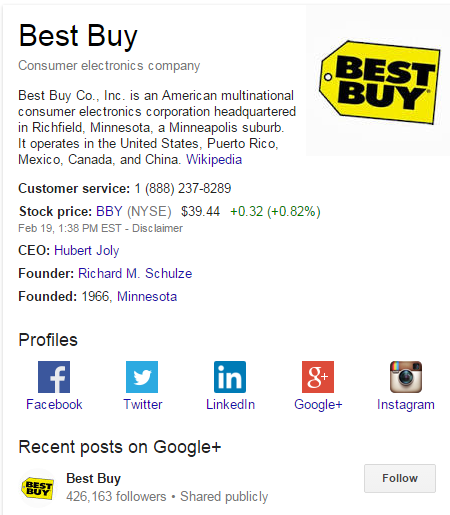
Just as in the past, you see a snapshot from the brand’s Wikipedia page (as many of us know, this is how most Knowledge Graphs are generated). Right below it, Best Buy’s social handles are displayed. By the way, Google currently picks up profiles from the top social networks (interestingly, MySpace is on the list):
• Facebook
• Twitter
• Google+
• Instagram
• YouTube
• LinkedIn
• Myspace
I do anticipate this list expanding. So, if Pinterest and Tumblr are an integral part of your marketing campaign, this is not by any means the reason to drop them and bring your brand back to the antique MySpace. Just like anything, take this update with a grain of salt and really think what the best strategy is for your brand.
However, even if you’re a small B2B business, this is a no-brainer to build out your profiles on top networks (at the very least, on Facebook, Twitter, Google+ and LinkedIn), just so you can own that Web real estate for the branded queries.
Now, Google+ is just as important as ever to your search campaigns. Below the social profiles’ links, Google Knowledge Graph displays your latest Google+ posts, followed by your competitors’ information. If you maintain solid presence in social channels and regularly update your brand’s Google+ page, you’d be able to push competitors’ mentions down the bottom of the Knowledge Graph panel and really dominate that digital real estate.
For example, in the following search results below, two competitive beauty brands, Kiehl’s and L’Occitane, both have solid Knowledge Graphs. However, due to the fact that more L’Occitane’s social profiles are picked up, in addition to the company’s Google+ updates, you have to scroll down the search engine result page to see competitive logos. In the Kiehl’s example, competitors’ presence is way more prominent:
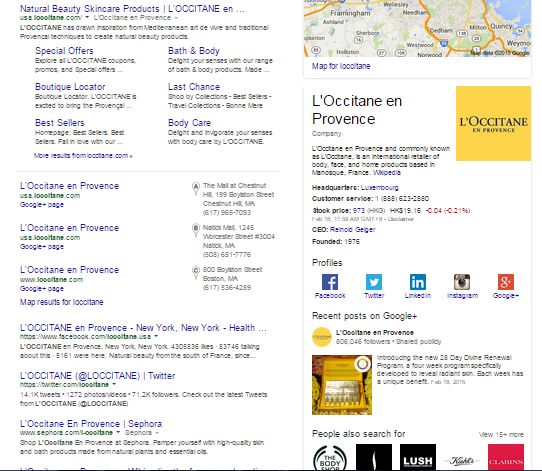
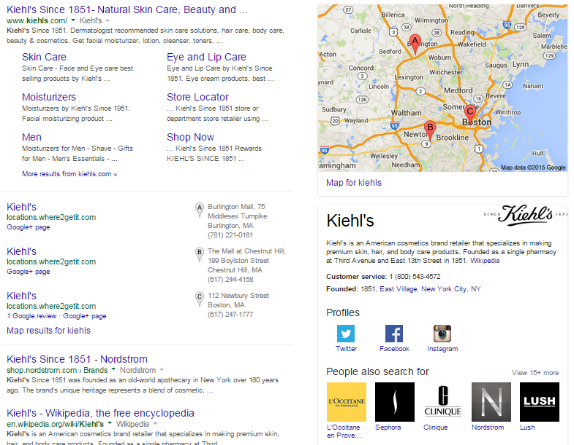
So, if you are serious about your brand’s digital marketing, I highly recommend that you add the following to your to do list:
• Invest effort in building out your brand’s presence in top social networks.
• Maintain active Google+ page.
• Implement Google-recommended structured data markup on your site to distinguish your brand’s official social profiles. Conveniently, Google outlines a detailed guide on how to implement this markup in its Developer’s Guide here: https://developers.google.com/structured-data/customize/social-profiles
I hope I convinced you to think about social marketing. Stay tuned on more updates on how to integrate search and social to really benefit your overall marketing efforts!
by Charles River Interactive | April 29, 2016 | Organic Search, SEO, SEO Blogs, Uncategorized
No website is perfect. But of all the potential issues that could affect user experience, none is so obvious as the one that announces itself: the 404 error. If a user encounters this issue on your or your client’s site, the server will clearly state there is a problem, usually with some variation of “404 error: Page not found.”
If you manage a very large site, 404 errors are inevitable at some point. The key is establishing a process to find and resolve them quickly and efficiently.
What is a 404 Error?
A 404 error is a page that was not properly removed from a website or redirected in your content management system (CMS). As a result, the page appears to live on the website, but it no longer exists on your server. If a user tries to visit the page, they receive an error message.
Regularly resolving your site’s 404 errors is a signal to Google that you are maintaining a healthy website. It also improves user experience by minimizing the number of broken pages visitors may encounter.
Tips for Managing 404 Errors
- Prioritize: If you have a large site with hundreds of 404 errors, the best option is to prioritize your efforts. Use Google Analytics (or your preferred web analytics platform) to evaluate how much organic traffic each 404 page has received over a predetermined period of time. Tackle the pages with the most traffic first, and work your way down.
- Automate: You can automate redirects using the .Htaccess file in your CMS. Choose which page you want to be the replacement for a 404 error page. It may be a custom redirect page, or you may want to send users back to your homepage or to a search function. Please note: An .htaccess file is an extremely sensitive file in your CMS. We highly recommend your IT department sign-off on any edits to an .htaccess file.
3 Tools for Fixing 404 Errors
Outlined below are some tools to effectively find and resolve 404 error pages.
Google Webmaster Tools
Google Webmaster Tools (a.k.a. Search Console) is a resource from Google that web developers use to monitor website issues and control how their sites appear in search results.
Assuming your GWT is verified, here are the steps you take:
1. Login
2. Select your domain
3. Select ‘Crawl’ on the left sidebar
4. Crawl Errors
5. Select ‘404 Errors’
6. Select ‘Download’ to export as Excel/CSV file
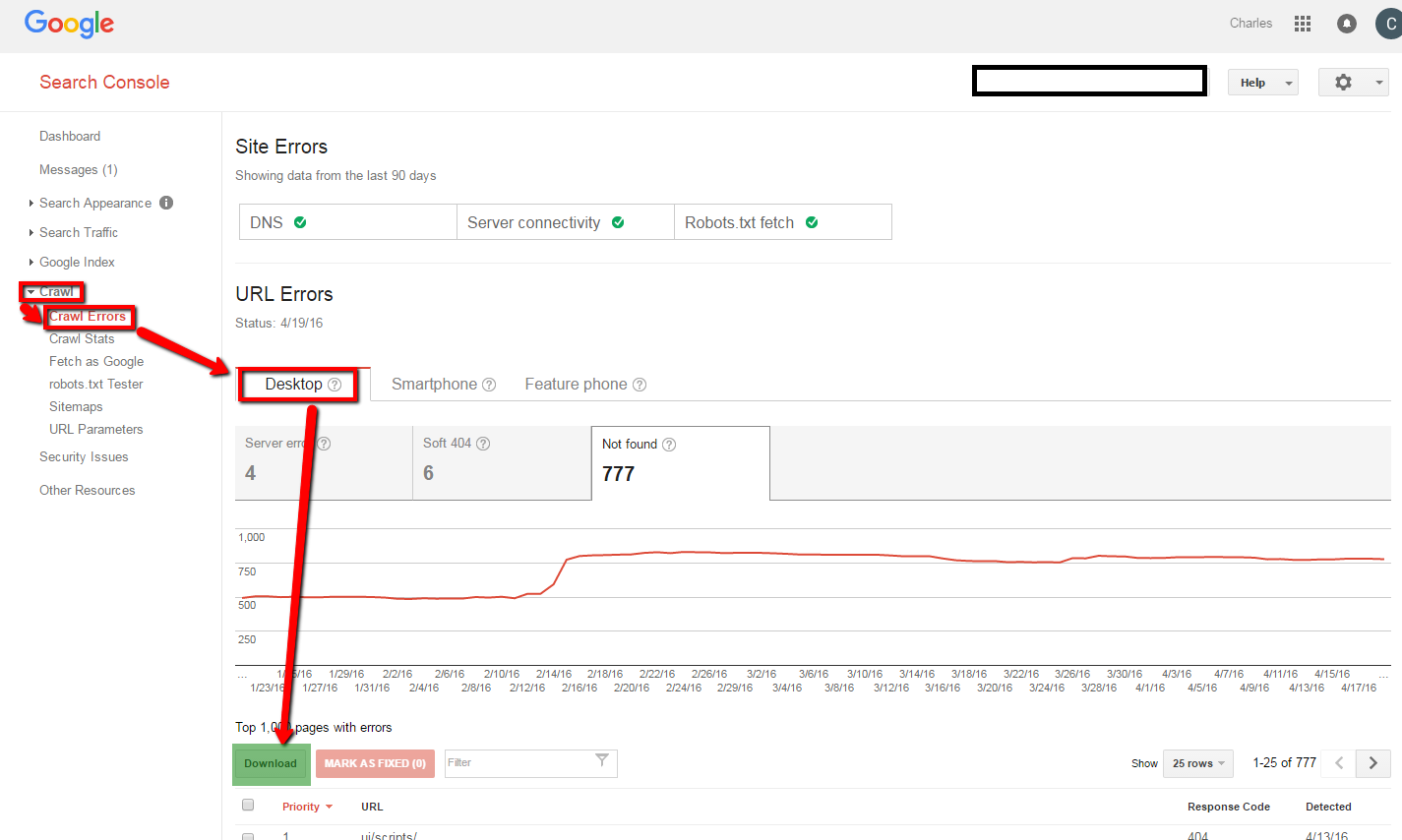
Screaming Frog (free and paid versions)
Screaming Frog’s SEO Spider is a tool that allows you to easily crawl hundreds of URLs for 404 errors. The free version will crawl up to 500 URLs; the paid version will crawl an unlimited number across your entire website. You just enter the URLs and the program creates a file ready for export.
Yoast SEO for WordPress (free and paid versions)
If you host your entire site or blog on WordPress, Yoast SEO (formerly known as WordPress SEO by Yoast) is a tool that can help you configure your pages for SEO. This plugin, which you download, allows you to edit your URLs, meta data, XML Sitemaps, as well as monitor for 404 errors via integration with Google Webmaster Tools. The premium version is available for $69/year for one site.
When to Use 301 Redirects
We highly recommend 301 redirects when you want to redirect individual pages or even entire websites. A 301 redirect is a permanent redirect from one URL to another. These types of redirects are especially useful when the missing page enjoyed a high organic search rank on search engines. The new, 301 redirect page maintains the SEO strength of the link even when redirected.
Sometimes there isn’t a good page to redirect to. In this case, a custom error page should be provided.
Creating Custom 404 Pages
If a permanent 301 redirect does not make sense, then you can consider creating a customized, visitor-friendly error page to appear in place of the missing URL. Typically, website use the same custom page across the site for 404 errors.
Custom error pages typically feature the following:
- A message to the user explaining that the page no longer exists
- A search box to help a visitor find exactly what they want
- A link to the home page
We hope this has been a helpful tutorial on how to find and fix 404 pages.
You can make it even easier on yourself and have Charles River Interactive give your site an in-depth SEO Analysis. Contact us today.
Interested in learning more tips for managing your website? Read more from our blog, View from the Charles:
3 Reasons to Use Google Tag Manager
Mobile Search Updates: Why You Need a Mobile Site







 An example of a Charles River Interactive analytics dashboard
An example of a Charles River Interactive analytics dashboard







